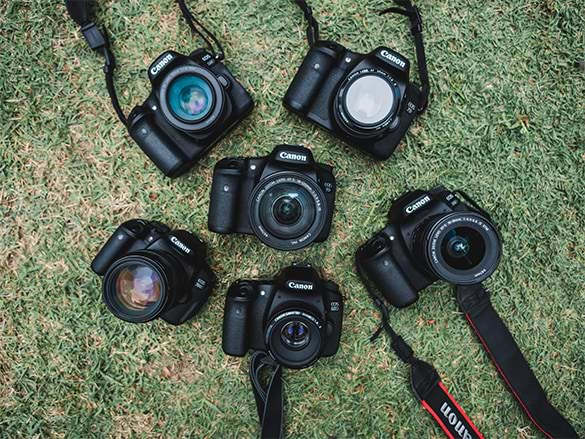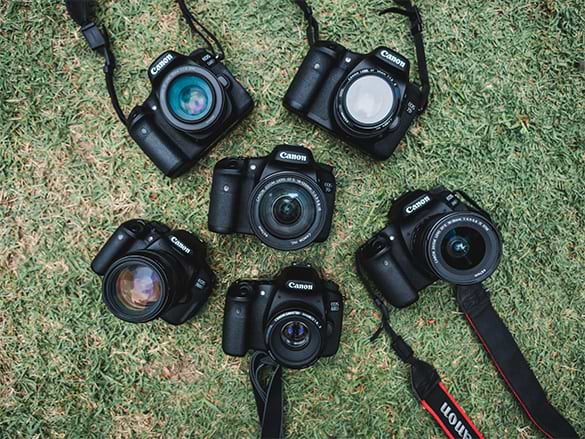Finding the right camera to truly fit your need can be a challenging task. With a seemingly unlimited range of options from DSLRs to action cameras, it can be hard to decide which option is right for you. This is where Croma steps in. We strive to help you buy. So let’s simplify the world of cameras and help you make an informed decision when picking your next camera. We’ll break down the various types of cameras, top technologies, specifications, features and accessories to give you the complete picture on how to make the right choice.

Contents
Types of Cameras
DSLRs – Digital Single Lens Reflex Cameras
DSLRs are the most popular form of cameras today, offering exceptional customizability and performance using interchangeable lenses. Packed with the latest features, capable sensors and manual settings, DSLRs produce premium quality images, used by amateurs and professionals.
Ideal for – Amateur Photographers, Professionals, Photography Enthusiasts
Mirrorless Cameras
The latest innovation in the camera category, mirrorless cameras offer the benefits of interchangeable lenses housed in a more compact, lightweight design compared to DSLRs. Top end models offer full frame sensors and exceptional low light performance. Mirrorless cameras have become the industry standard for excellent video performance.
Ideal for – Video Content Creators, Professionals
Action Cameras
Sport and action cameras are designed to be capable companions on your outdoor adventures, offering features such as 4K video capture, burst photography and extremely high durability, while eliminating the need to hold a camera and manually click photos.
Ideal for – Outdoor Activities (Trekking, sports, hikes, swimming), Nature Photography
Point & Shoot Cameras
With compact, lightweight designs, these versatile cameras are ideal for casual photography and can definitely pack a punch. Latest compact cameras have integrated high zoom capabilities, wireless connectivity and weather resistance to improve user experience.
Ideal for – Amateur photographers, Fashion Bloggers
| DSLR CAMERA BENEFITS | MIRRORLESS CAMERA BENEFITS |
|---|---|
| Electronic Viewfinder – Shows the actual view through the camera. | Optical Viewfinder – Improved clarity and dynamic range. |
| Wider range of lens options and flexibility. | Lightweight compact designs, smaller than equivalent DSLRs. |
| Well-equipped autofocus system, provides great results. | Faster shooting speed, allowing more shots in the same time. |
| Exceptional image quality with a wide range of customization options. | Exceptional video quality with lots of dedicated features. |
| Longer battery life. | Better for silent operation with barely any shutter noise. |
Which specifications to look out for?
Megapixels (MP) – The Megapixels indicate the resolution of the camera, greater the megapixels, higher the quality of the image produced. For photographers making large print photos, higher megapixel count is important, to ensure quality maintains over the larger image size.
ISO Range – ISO defines the cameras sensor’s light sensitivity. Higher ISO ranges allow users to shoot better in low light conditions. Cameras with ISO 1600 or higher are generally recommended, but options today range up to ISO 25000 – 102000.
Manual Mode – Offers user complete control over the image produced. As opposed to auto mode, where the camera picks shutter speed, aperture and ISO, manual mode gives users full control over picking the settings to achieve the shot they want.
Ergonomic Aspects – Be sure to look into the size, weight and comfort of use for your camera choice. For amateur photographers, it is advisable to pick lightweight easy to use cameras. Check on the build quality of the device as well.
Display – LCD screens are common on most cameras today, but be sure to check on the resolution and the brightness of the display. The resolution defines the quality of the image on the camera and high brightness enables outdoor use. A tilt screen is a useful feature as well.
Autofocus – Focus is an essential component in photography, with the right focus pushing your photos to the next level. Quality of the autofocus system is important to consider when picking your camera. The number of autofocus points is a good measure of the focus quality.
Which features really matter?
Image Stabilization – Takes out the blur in your pictures by reducing the effect of movement and vibration of the camera. Optical Image Stabilization (OIS) built-in to cameras automatically correct for movement providing clearer photos.
Wireless Connectivity – Modern cameras today are often equipped with Wi-Fi, NFC and GPS technologies integrated, which make uploading photos directly from your camera a lot easier. Sharing location tagged images on social networking sites has never been simpler.
Video Recording – Most cameras support video recording, with resolutions from HD to 4K widely available. Check in on the resolution, frames per second (fps) and manual control to ensure premium video recording.
Panorama and Burst Mode – Allowing users to capture multiple shots stitched together automatically to produce an extremely wide view, ideal for landscapes and wildlife. Burst mode is perfect for moving subjects, capturing a large number of shots in a very short time.
Viewfinder – While DSLRs have mirrors allowing users to look through the lens, mirrorless and compact cameras have LCD screens and may have electronic viewfinders, which display an image based on your settings.
Cleaning System –Cameras integrate cleaning technology to remove dust from the image sensor, a useful feature for outdoor photographers. Check in on the automatic cleaning system offered by your camera.
Camera Accessories
The Essentials – Must haves for ensuring smooth usage and operation of your camera.
1. Memory Cards – Used to store and record the images and video shot on a camera. Ensure you check on the type of memory card and compatibility with your camera and the read/write speeds offered.
2. Camera Bag – For people who travel with their cameras, a camera bag can serve the dual purposes of protecting their equipment as well as making it convenient to carry the camera around. Ensure your bag is lightweight and sized adequately to carry your camera.
3. Extra Battery – Nothing is worse than having your camera run out of battery right before you can get that perfect shot. Be sure to pick up some extra batteries to ensure you can always be ready to shoot on-the-go.
4. Memory Card Reader – Most photographers are already used to utilizing a card reader to transfer their images rather than the USB cable provided with the camera due to faster speeds and convenience. For first timers it is important to ensure you get a reader to save on time transferring data.
Optional Accessories – Allow you to add new levels to your photography.
1. Tripods – Ideal for landscape photographers or long exposure photography, a tripod provides a stand for your camera to achieve that perfectly steady shot. Be sure to check the compatibility of the camera with the tripod.
2. Filters – Alter the effects of light and provide a unique look to your pictures, extending your creative influence. Common filters include UV Filters, Polarity Filters and Density Filters. Filters have the added function of protecting the lens from scratches.
3. Battery Grips – A grip with embedded battery serves two purposes, it extends the shooting time of your camera and alters the shape of the camera body, improving on comfort shooting from the vertical position.
4. Remote – Allows users to control the camera wirelessly, ideal for selfies or group shots. Check in on the compatibility of the remote with the camera before you pick one. A remote can drastically improve on the accessibility of your camera.
[“source=croma”]










